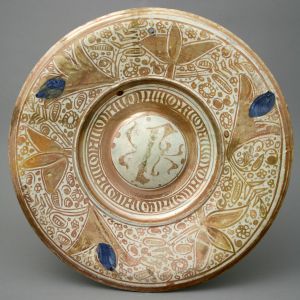MUO-001826: Tanjur: tanjur
Inventarna oznaka
MUO-001826
Naziv zbirke
Književni naziv
Naslov predmeta
Tanjur
Država nastanka
Stoljeće nastanka
16. – . st.
Materijal izrade
Opis predmeta
Na žućkastoj ocaklini lister-ornamenti.
//
Izloženi pladanj jedan je od desetak hispano-moresknih pladnjeva iz ostavštine katalonskoga slikara Mariana Josea Bernarda Fortunyja y Carba, otkupljenih na aukciji u Parizu za fundus budućega Muzeja za umjetnost i obrt još 1875. godine. Pladanj je ukrašen vegetabilnim slikanim ukrasima, a lüster je kombiniran s modrom ocaklinom. Jednostavan oblik pladnja s ispupčenim srednjim dijelom pokazuje inspiraciju oblicima metalnoga posuđa. Ukrašavanje posuđa lüster ocaklinom donose u Europu u 14. stoljeću maurski lončari, a najznačajniji centri proizvodnje bili su španjolski gradovi Malaga, Valencia i Aragon. Tradicija proizvodnje posuđa ukrašenog lüster ocaklinom očuvala se u Španjolskoj još i danas. Od 16. stoljeća ovu tehniku ukrašavanja preuzimaju i talijanski lončari u radionicama u Gubbiju, Deruti i Caffaggiolu.
Ključne riječi
MUO baza
Autorska prava / Prava korištenja
